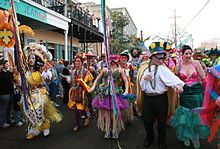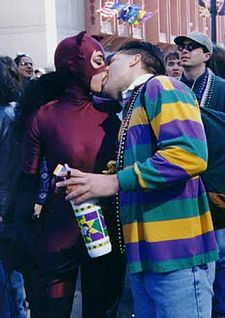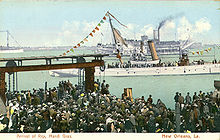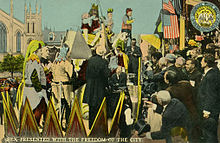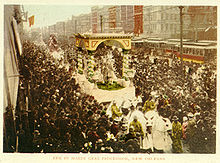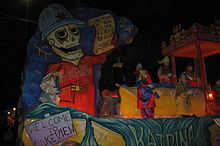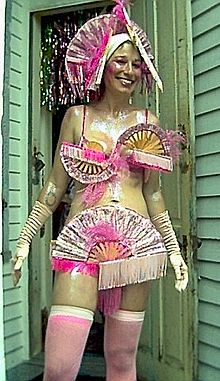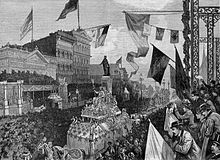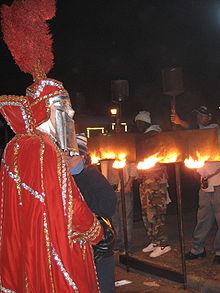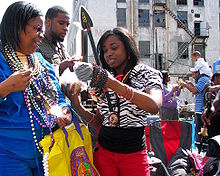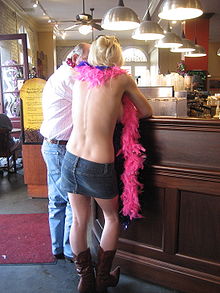- New Orleans Mardi Gras
-
Mardi Gras (Fat Tuesday in English) in New Orleans, Louisiana, is a Carnival celebration well-known throughout the world.
The New Orleans Carnival season, with roots in preparing for the start of the Christian season of Lent, starts after Twelfth Night, on Epiphany (January 6). It is a season of parades, balls (some of them masquerade balls), and king cake parties. It has traditionally been part of the winter social season; at one time "coming out" parties for young women at débutante balls were timed for this season.
Celebrations are concentrated for about two weeks before and through Fat Tuesday (Mardi Gras in French), the day before Ash Wednesday. Usually there is one major parade each day (weather permitting); many days have several large parades. The largest and most elaborate parades take place the last five days of the season. In the final week of Carnival, many events large and small occur throughout New Orleans and surrounding communities.
The parades in New Orleans are organized by Carnival krewes. Krewe float riders toss throws to the crowds; the most common throws are strings of plastic colorful beads, doubloons (aluminum or wooden dollar-sized coins usually impressed with a krewe logo), decorated plastic throw cups, and small inexpensive toys. Major krewes follow the same parade schedule and route each year.
While many tourists center their Mardi Gras season activities on Bourbon Street and the French Quarter, none of the major Mardi Gras parades has entered the Quarter since 1972 because of its narrow streets and overhead obstructions. Instead, major parades originate in the Uptown and Mid-City districts and follow a route along St. Charles Avenue and Canal Street, on the upriver side of the French Quarter.
To New Orleanians, "Mardi Gras" specifically refers to the Tuesday before lent, the highlight of the season. The term can also be used less specifically the whole Carnival season, sometimes as "the Mardi Gras season". The term "Fat Tuesday" or "Mardi Gras Day" always refers only to that specific day.
Contents
History
The celebration of Mardi Gras was brought to Louisiana by early French settlers. The first record of the holiday being celebrated in Louisiana was at the mouth of the Mississippi River in what is now lower Plaquemines Parish, Louisiana, on March 3, 1699. Iberville, Bienville, and their men celebrated it as part of an observance of Catholic practice.
The starting date of festivities in New Orleans is unknown. An account from 1743 notes that the custom of Carnival balls was already established. Processions and wearing of masks in the streets on Mardi Gras took place. They were sometimes prohibited by law, and were quickly renewed whenever such restrictions were lifted or enforcement waned. In 1833 Bernard Xavier de Marigny de Mandeville, a rich plantation owner of French descent, raised money to fund an official Mardi Gras celebration.
James R. Creecy in his book Scenes in the South, and Other Miscellaneous Pieces describes New Orleans Mardi Gras in 1835:[1]
Shrove Tuesday is a day to be remembered by strangers in New Orleans, for that is the day for fun, frolic, and comic masquerading. All of the mischief of the city is alive and wide awake in active operation. Men and boys, women and girls, bond and free, white and black, yellow and brown, exert themselves to invent and appear in grotesque, quizzical, diabolic, horrible, strange masks, and disguises. Human bodies are seen with heads of beasts and birds, beasts and birds with human heads; demi-beasts, demi-fishes, snakes' heads and bodies with arms of apes; man-bats from the moon; mermaids; satyrs, beggars, monks, and robbers parade and march on foot, on horseback, in wagons, carts, coaches, cars, &c., in rich confusion, up and down the streets, wildly shouting, singing, laughing, drumming, fiddling, fifeing, and all throwing flour broadcast as they wend their reckless way.
On Mardi Gras of 1857, the Mystick Krewe of Comus held its first parade. Comus is the oldest continuously active Mardi Gras organization. It started a number of continuing traditions. It is considered the first Carnival krewe in the modern sense. According to one historian, "Comus was aggressively English in its celebration of what New Orleans had always considered a French festival. It is hard to think of a clearer assertion than this parade that the lead in the holiday had passed from French-speakers to Anglo-Americans. . . .To a certain extent, Americans 'Americanized' New Orleans and its Creoles. To a certain extent, New Orleans 'creolized' the Americans. Thus the wonder of Anglo-Americans boasting of how their business prowess helped them construct a more elaborate version of the old Creole Carnival. The lead in organized Carnival passed from Creole to American just as political and economic power did over the course of the nineteenth century. The spectacle of Creole-American Carnival, with Americans using Carnival forms to compete with Creoles in the ballrooms and on the streets, represents the creation of a New Orleans culture neither entirely Creole nor entirely American."[2]
In 1875 Louisiana declared Mardi Gras a legal state holiday.[3] War, economic, political, and weather conditions sometimes led to cancellation of some or all major parades, especially during the American Civil War, World War I and World War II, but the city has always celebrated Carnival.[3]
1972 was the last year in which large parades went through the narrow streets of the city's old French Quarter neighborhood; larger floats, crowds, and safety concerns led the city government to prohibit big parades in the Quarter. Major parades now take place outside the Quarter, especially on the wider Canal Street.
In 1979 the New Orleans police department went on strike. The official parades were canceled or moved to surrounding communities, such as Jefferson Parish. Significantly fewer tourists than usual came to the city. Masking, costuming, and celebrations continued anyway, with National Guard troops maintaining order. Guardsmen prevented crimes against persons or property but made no attempt to enforce laws regulating morality or drug use; for these reasons, some in the French Quarter bohemian community recall 1979 as the city's best Mardi Gras ever.
In 1991 the New Orleans City Council passed an ordinance that required social organizations, including Mardi Gras Krewes, to certify publicly that they did not discriminate on the basis of race, religion, gender or sexual orientation, to obtain parade permits and other public licenses.[4] In effect, the ordinance required these, and other, private social groups to abandon their traditional code of secrecy and identify their members for the city's Human Relations Commission. In protest, the 19th-century krewes Comus and Momus stopped parading.[5] Proteus did parade in the 1992 Carnival season but also suspended its parade for a time, returning to the parade schedule in 2000.
Two federal courts later declared that the ordinance was an unconstitutional infringement on First Amendment rights of free association, and an unwarranted intrusion on the privacy of the groups subject to the ordinance.[6] The US Supreme Court refused to hear the city's appeal from this decision.
Today, most krewes operate under a business structure; membership is open to anyone who pays dues, and any member can have a place on a parade float. In contrast, the old-line krewes were social groups that reinforced class and economics to create exclusive groups. They used the structure of the parades and balls to extend the traditions in their social circles of the debutante season.
The devastation caused by Hurricane Katrina in late 2005 caused a few people to question the future of the city's Mardi Gras celebrations. Mayor Nagin, who was up for reelection in early 2006, tried to play this sentiment for electoral advantage[citation needed]. However, the economics of Carnival were, and are, too important to the city's revival.
The city government, essentially bankrupt after Hurricane Katrina, pushed for a scaled back celebration to limit strains on city services. However, many krewes insisted that they wanted to and would be ready to parade, so negotiations between krewe leaders and city officials resulted in a compromise schedule. It was scaled back but less severely than originally suggested.
The 2006 New Orleans Carnival schedule included the Krewe du Vieux on its traditional route through Marigny and the French Quarter on February 11, the Saturday two weekends before Mardi Gras. There were several parades on Saturday, February 18, and Sunday the 19th a week before Mardi Gras. Parades followed daily from Thursday night through Mardi Gras Day. Other than Krewe du Vieux and two Westbank parades going through Algiers, all New Orleans parades were restricted to the Saint Charles Avenue Uptown to Canal Street route, a section of the city which escaped significant flooding. Some krewes unsuccessfully pushed to parade on their traditional Mid-City route, despite the severe flood damage suffered by that neighborhood.
The city restricted how long parades could be on the street and how late at night they could end. National Guard troops assisted with crowd control for the first time since 1979. Louisiana State troopers also assisted, as they have many times in the past. Many floats had been partially submerged in floodwaters for weeks. While some krewes repaired and removed all traces of these effects, others incorporated flood lines and other damage into the designs of the floats.
Most of the locals who worked on the floats and rode on them were significantly affected by the storm's aftermath. Many had lost most or all of their possessions, but enthusiasm for Carnival was even more intense as an affirmation of life. The themes of many costumes and floats had more barbed satire than usual, with commentary on the trials and tribulations of living in the devastated city. References included MREs, Katrina refrigerators and FEMA trailers, along with much mocking of the Federal Emergency Management Agency (FEMA) and local and national politicians.
By the 2009 season, the Endymion parade had returned to the Mid-City route, and other Krewes expanding their parades Uptown.
Traditional colors
Meaning of Colors Justice (purple) Power (gold) Faith (green) The traditional colors of Mardi Gras are purple, green, and gold. These colors are said to have been chosen by Grand Duke Alexis Alexandrovitch Romanoff of Russia during a visit to New Orleans in 1872.[7] This doctrine was reaffirmed in 1892, when the Rex Parade theme "Symbolism of Colors" gave the colors their meanings.[7]
In his book "Krewe: The Early New Orleans Carnival: Comus to Zulu," Errol Laborde shows the above mentioned meanings of the Mardi Gras colors to be false. He gives a much simpler origin, having to do primarily with looking good.[8]
Contemporary Mardi Gras
Each year the Mardi Gras (or Carnival) season starts on January 6, also known as Twelfth Night. The Twelfth Night Revelers, one of Carnival's oldest Krewes, holds a masked ball each year to mark the occasion. Many of Carnival's oldest groups such as the Elves of Oberon and the High Priests of Mithras hold masked balls, but do not parade in public.
The parade season starts off some three weekends before Mardi Gras Day with the Krewe du Vieux parade. There is usually at least one parade every night starting two Fridays before Mardi Gras.
Weekend before Mardi Gras
The population of New Orleans more than doubles with visitors this day. Thursday night starts off with a bang with an all-women's parade featuring the Krewe of Muses. The parade is relatively new, but its membership has tripled since its start in 2001. It is popular for its throws (highly sought after decorated shoes and other trinkets) and themes poking fun at politicians and celebrities. Friday night is the occasion of the large Krewe of Hermes and satirical Krewe D'État parades, ending with one of the fastest growing krewes, the Krewe of Morpheus[9] There are several smaller neighborhood parades like the Krewe of Barkus and the Krewe of OAK. Several daytime parades roll on Saturday (including Krewe of Tucks) and Sunday (Okeanos and Thoth). The first of the "super krewes", Endymion, parades on Saturday night, with the celebrity-led Bacchus parade on Sunday night.
Lundi Gras
Monday is known as Lundi Gras ("Fat Monday"). The monarchs of the Zulu Social Aid & Pleasure Club and Krewe of Rex, who will parade the following day, arrive by boat on the Mississippi River front at the foot of Canal Street, where an all-day party is staged. Uptown parades start with the parade of one of New Orleans' most prestigious organizations, the Krewe of Proteus. Dating back to 1882, it is the second oldest krewe still parading in the city. The Proteus parade is followed by a newer organization, the music-themed super-Krewe of Orpheus, which is considered less prestigious as it draws a significant portion of its membership from outside the City.
Mardi Gras Day
Celebrations begin early on Mardi Gras Day, which can fall on any Tuesday between February 3 and March 9 (depending on the date of Easter).[10] Uptown, the Zulu parade rolls first, followed by the Rex parade, which both end on Canal Street. A number of smaller parading organizations with "truck floats" follow the Rex parade.
Numerous smaller parades and walking clubs also parade around the city. The Jefferson City Buzzards, the Lyons Club, the Irish Channel Corner Club, Pete Fountain's Half Fast Walking Club and the KOE all start early in the day Uptown and make their way to the French Quarter with at least one jazz band. At the other end of the old city, the Society of Saint Anne journeys from the Bywater through Marigny and the French Quarter to meet Rex on Canal Street. The Pair-O-Dice Tumblers rambles from bar to bar in Marigny and the French Quarter from noon to dusk. Various groups of Mardi Gras Indians, divided into uptown and downtown tribes, parade in their finery.
For upcoming Mardi Gras Dates through 2050 see Mardi Gras Dates.
Costumes and masks
Costumes and masks are seldom publicly worn by non-Krewe members on the days before Fat Tuesday (other than at parties), but are frequently worn on Mardi Gras Day. Laws against concealing one's identity with a mask are suspended for the day. Banks are closed, and some businesses and other places with security concerns (such as convenience stores) post signs asking people to remove their masks before entering.
Commercialization
Orleans Parish has laws prohibiting any form of commercial advertising on Carnival parades. Mardi Gras is a traditional holiday, so there is no such thing as an official Mardi Gras product or sponsor, any more than there can be, say, an official sponsor of Christmas. Nonetheless, many merchants sell so-called "official" merchandise to visiting tourists. A common con often played on tourist is a "ticket" to Mardi Gras. There is no official invitation-only celebration that requires a ticket. Mardi Gras is composed of various events such as balls for social clubs in the New Orleans Area, but the main event is simply a street festival, open to the public. Some individual krewes do, however, produce an official poster of their organization each year. There are viewing stands erected along St. Charles Avenue which require a ticket for seating.
The one exception to the lack of official sponsorship was the 2006 Mardi Gras season. Due to budget problems following Hurricane Katrina, the city of New Orleans offered the opportunity for four companies to become the first corporate sponsors of Mardi Gras. National media buying club MediaBuys.com was selected by the city to locate sponsors in a 30-day window. There was concern that without this drastic step, the city government would lack funds to provide basic services for the parades. Glad was the only company to take the offer. In addition to its significant program commitment, Glad worked with the City of New Orleans Department of Sanitation in the carnival's sanitation maintenance and clean-up efforts, which would otherwise have mounted a considerable expense for the municipality.
Beads
Inexpensive strings of beads and toys have been thrown from floats to parade-goers since at least the late 19th century. Until the 1960s, the most common form was multi-colored strings of glass beads made in Czechoslovakia. These were supplanted by less expensive and more durable plastic beads, first from Hong Kong, then from Taiwan, and more recently from China. Lower-cost beads and toys allow riders to purchase greater quantities and throws have become more numerous and common.
In the 1990s, many people lost interest in small, cheap beads, often leaving them where they landed on the ground. Larger, more elaborate metallic beads and strands with figures of animals, people, or other objects have become the sought-after throws. David Redmon's 2005 film of cultural and economic globalization, Mardi Gras: Made in China, follows the production and distribution of beads from a small factory in Fuzhou, China to the streets of New Orleans during Carnival.[11]
With the advent of the 21st century, more sophisticated throws began to replace simple metallic beads. Krewes started to produce limited edition beads and plush toys that are unique to the krewe. Fiber optic beads and LED-powered prizes are now among the most sought-after items. In a retro-inspired twist, glass beads have returned to parades. Now made in India, glass beads are one of the most valuable throws.
Other Mardi Gras traditions
Social clubs
Social clubs play a very large part in the Mardi Gras celebration as hosts of many of the parades on or around Mardi Gras Day. The two main Mardi Gras Day parades, Zulu and Rex, are both social club parades. Zulu is a mostly African-American club and Rex is mostly Caucasian. Social clubs host Mardi Gras balls, starting in late January. At these social balls, the queen of the parade (usually a young woman between the ages of 18 and 21, not married and in high school or college) and the king (an older male member of the club) present themselves and their court of maids (young women aged 16 to 18), and different divisions of younger children with small roles in the ball and parade, such as a theme-bearer.
This tradition began in 1872, when New Orleans officials, in a quandary regarding who - in a city free of nobility - should greet Grand Duke Romanoff during his visit, formulated an elegant solution. They formed the Krewe of Rex and named a de facto "king for the day" to receive their royal guest. Rex was made up of people from the white social elite of the city, heavily influenced by those of French descent.[12]
In response to the their exclusion from Rex, in 1909 Créole and black New Orleanians, led by a mutual aid group known as "The Tramps", adorned William Storey with a tin can crown and banana stalk scepter and named him King Zulu.[4][12] This display was meant as a mockery of Rex's overstated pageantry, but in time, Zulu became a grand parade in its own right. By 1949, as an indication of Zulu's increase in prestige, the krewe named New Orleans' native son Louis Armstrong as its king.[3]
Being a member of the court requires much preparation, usually months ahead. Women and girls must have dress fittings as early as the May before the parade, as the season of social balls allows little time between each parade. These balls are generally by invitation only and are hosted at the Ernest N. Morial Convention Center.
Doubloons
One of the many Mardi Gras throws which krewes fling into the crowds, doubloons are large coins, either wood or metal, made in Mardi Gras colors. Artist H. Alvin Sharpe created the modern doubloon for The School of Design (the actual name of the Rex organization). According to the krewe history, in January 1959 Sharpe arrived at the offices of the captain of the krewe with a handful of aluminum discs. Upon entering the office, he threw the doubloons into the captain's face to prove that they would be safe to throw from the floats. Standard krewe doubloons usually portray the Krewe's emblem, name, and founding date on one side, and the theme and year of the parade and ball on the other side. Royalty and members of the court may throw specialty doubloons, such as the special Riding Lieutenant doubloons given out by men on horseback in the Rex parade. In the last decade, krewes have minted doubloons specific to each float. Krewes also mint special doubloons of cloisonné or pure silver for its members. They never throw these from the floats. Original Rex doubloons are valuable, but it is nearly impossible for aficionados to find a certified original doubloon. The School of Design did not begin dating their doubloons until a few years after their introduction.
Flambeau carriers
The flambeau ("flahm-bo" meaning flame-torch) was originally a carrier that served as a beacon for parade goers to better enjoy the spectacle of night festivities. The first flambeau carriers were slaves. Today, the flambeaux are a direct connection to the original days of Carnival and a valued tradition. Many view the flambeaux as a kind of performance art, a valid assessment given the wild gyrations and flourishes common to experienced flambeau carriers.
Parades that commonly feature flambeau carriers include Babylon, Chaos, d'Etat, Druids, Hermes, Muses, Orpheus, Proteus, Saturn, and Sparta. Many of the flambeau carriers today are descended from long lines of carriers, some going back to the days of slavery. Flambeaux are powered by naphtha[citation needed], a highly flammable aromatic. It is tradition when the flambeau carriers pass to toss quarters to them in thanks for carrying the lights of Carnival.
King cake
The first week of January in New Orleans starts the King cake season. King cakes first appeared after 1872, when the Rex Krewe selected the Mardi Gras colors (purple, green and gold). The traditional King cake is a coffee cake, and is oblong and braided. It is iced with a simple icing and covered with purple, green and gold sugar. Each cake contains a hidden bean or small plastic baby, and custom tells that whoever finds it must either buy the next King cake or throw the next King cake party. One Mardi Gras organization uses the King cake tradition to choose the queen of its annual ball. Hundreds of King cake parties are thrown every year and hundreds of thousands of cakes are made, bought and eaten every year.
Mardi Gras icons
- Faces of Comedy and Drama
- Feathered masks
- Fleur de Lis
- Laissez Les Bons Temps Rouler! (French: "Let the good times roll!")
- Throw me something, Mister!
- If Ever I Cease to Love
- Mardi Gras Mambo
Zulu or Mardi Gras Coconut
One of the most famous and the most sought after throws, is the Zulu Coconut also known as the Golden Nugget and the Mardi Gras Coconut.[5] The coconut is mentioned as far back as 1910, where they were given in a natural "hairy" state. The coconut was thrown as a cheap alternative, especially in 1910 when the bead throws were made of glass. Before the Krewe of Zulu threw coconuts, they threw walnuts that were painted gold. This is where the name "Golden Nugget" originally came from. It is thought that Zulu switched from walnuts to coconuts in the early 1920s when a local painter, Lloyd Lucus, started to paint coconuts. Most of the coconuts have two decorations. The first is painted gold with added glitter, and the second is painted like the famous black Zulu faces. In 1988, the city forbade Zulu from throwing coconuts due to the risk of injury; they are now handed to onlookers rather than thrown. In the year 2000, a local electronics engineer, Willie Clark, introduced an upgraded version of the classic, naming them Mardi Gras Coconuts. These new coconuts were first used by the club in 2002, giving the souvenirs to royalty and city notables.
Exposure and Mardi Gras
In the last decade of the 20th century, the rise in producing commercial videotapes catering to voyeurs helped encourage a tradition of women baring their breasts in exchange for beads and trinkets.[13]
Women showing their breasts during Mardi Gras has been documented since 1889, when the Times-Democrat decried the "degree of immodesty exhibited by nearly all female masqueraders seen on the streets." The practice was mostly limited to tourists in the upper Bourbon Street area.[3][13] In the crowded streets of the tourist section of the French Quarter, generally avoided by locals, flashers on balconies cause crowds to form on the streets.
End of each Mardi Gras
The formal end of Mardi Gras arrives with "the Meeting of the Courts", a term describing the ceremony at which Rex and His Royal Consort, the King and Queen of Carnival, meet with Comus and his Queen at the ball of the Mistick Krewe of Comus, New Orleans' oldest active Carnival organization. The Meeting of the Courts happens at the conclusion of the two groups' masked balls, which in modern times have both been held at the New Orleans Municipal Auditorium. Since 2006, following Hurricane Katrina, the Ball has been held in the Marriott Hotel.
Promptly at the stroke of midnight at the end of Fat Tuesday, a mounted squad of New Orleans police officers make a show of clearing upper Bourbon Street where the bulk of out-of-town revelers congregate, announcing that Mardi Gras is over, as it is the start of Lent, commencing with Ash Wednesday.
Ash Wednesday (the day after Fat Tuesday) is sometimes jokingly referred to as "Trash Wednesday" because of the amount of refuse left in the streets by the previous day's celebrations. The tons of garbage picked up by the city sanitation department is a local news item, as it also reflects the positive economic impact of tourists at each year's celebration of Mardi Gras.
Additional photographs
References
- ^ Creecy, James R. (1860). Scenes in the South, and Other Miscellaneous Pieces. Washington: T. McGill. pp. 43, 44. OCLC 3302746. http://books.google.com/books?id=ciYUAAAAYAAJ&printsec=frontcover&dq=Scenes+in+the+South,+and+Other+Miscellaneous+Pieces#v=onepage&q=&f=false.
- ^ All on a Mardi Gras Day: Episodes in the History of New Orleans Carnival by Reid Mitchell. Harvard University Press:1995. ISBN 067401622X pg 25, 26
- ^ a b c d Sparks, R. American Sodom: New Orleans Faces Its Critics and an Uncertain Future. La Louisiane à la dérive. The École des Hautes Études en Sciences Sociales Coloquio - December 16, 2005.
- ^ a b Three centuries of Mardi Gras history. From: carnaval.com. Retrieved October 19, 2007.
- ^ a b Deja Krewe. The Times-Picayune. Retrieved October 19, 2007.
- ^ The decision of the Fifth Circuit Court of Appeals appears at volume 42, page 1483 of the Federal Reporter (3rd Series), or 42 F.3d 1483 (5th Cir. 1995).
- ^ a b Mardi Gras - Laissez les bons temps rouler. From: novareinna.com. Retrieved October 19, 2007.
- ^ Laborde, Errol (2007). Krewe: The Early New Orleans Carnival: Comus to Zulu. Metairie, La.: Carnival Press. pp. 57–61. ISBN 9780979227301.
- ^ Krewe of Morpheus website
- ^ Mardi Gras dates
- ^ David Redmon (2008). Mardi Gras: Made in China. Culture Unplugged. Retrieved 2010-02-16.
- ^ a b Mardi Gras History. From: mardigrasneworleans.com. Retrieved October 19, 2007.
- ^ a b Shrum, W. and J. Kilburn. "Ritual Disrobement at Mardi Gras: Ceremonial Exchange and Moral Order". Social Forces, Vol. 75, No. 2. (Dec., 1996), pp. 423-458.
External links
- Carnival New Orleans History of Mardi Gras with vintage and modern pictures
- Mardi Gras Unmasked Definitive Mardi Gras and King Cake histories
- MardiGras.com Web site affiliated with New Orleans' Times-Picayune newspaper
- Mardi Gras New Orleans Emphasizes the family and traditional aspects
- Prof. Carl Nivale's Compleat Carnival Compendium and Mardi Gras Manual A family friendly site from WWL-TV personality and historian Professor Carl Nivale
Parades at Mardi Gras in New Orleans Old Line Krewes Mistick Krewe of Comus | Knights of Momus | Rex | Krewe of Proteus
Super Krewes Parading Krewes Krewe du Vieux | Krewe of Druids | Krewe of Babylon | Krewe of King Arthur | Krewe of Muses | Knights of Chaos | Krewe of Hermes | Le Krewe d'Etat | Krewe of Mid-City | Krewe of Thoth | Krewe of Iris | Krewe of Tucks | Krewe of Morpheus | Zulu Social Aid & Pleasure Club | Krewe of OAK | KOE (Krewe of Elvis) | Krewe of Pontchartrain | Phorty Phunny Phellows | Intergalactic Krewe of Chewbacchus
Non-Parading Krewes
that present debutantesTwelfth Night Revelers | Elves of Oberon | Krewe of Athenians | The Atlanteans | The Harlequins | Krewe of Olympians | Mystery | Caliphs of Cairo | Krewe of Nereus | High Priests of Mithras | Prophets of Persia | Krewe of Dorians | Krewe of Osiris | Krewe of Achaeans
Walking Clubs Half-Fast Walking Club | North Side Skull and Bones Gang | Society of Saint Anne | Krewe of Barkus | Jefferson City Buzzards| Irish Channel Corner Club
Indian Tribes Wild Tchoupitoulas | Creole Wild West | Yellow Pocahontas | Wild Magnolias
Related Categories:- Economy of New Orleans, Louisiana
- Events affected by Hurricane Katrina
- Festivals in Louisiana
- Mardi Gras in New Orleans, Louisiana
- Visitor attractions in New Orleans, Louisiana
Wikimedia Foundation. 2010.

